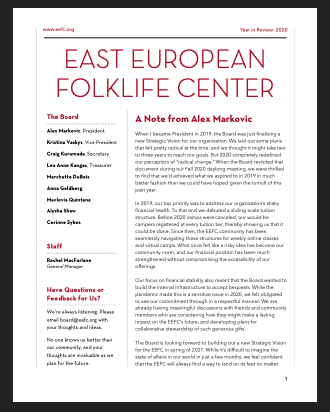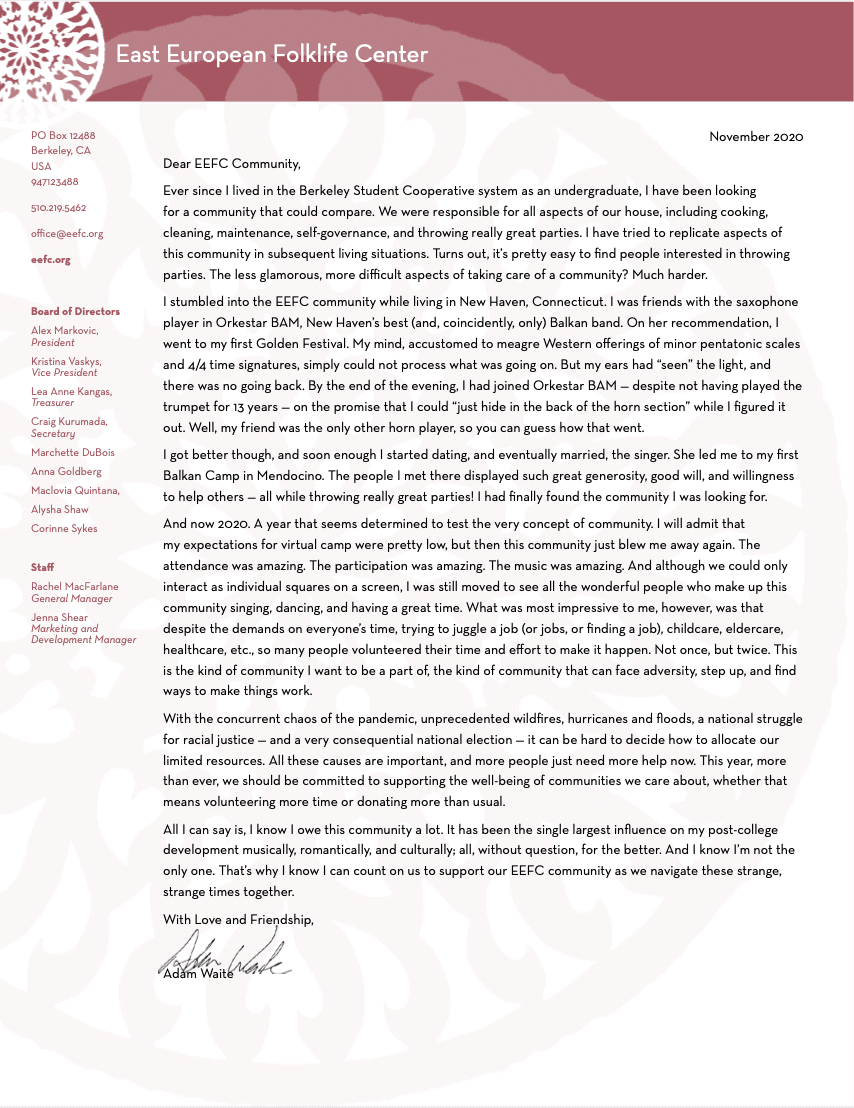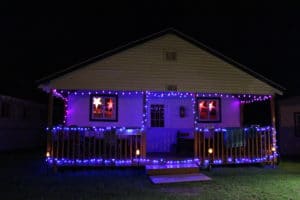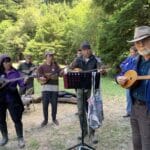
Archives
Fall 2020 Letter to the Community
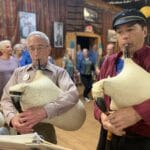
As many of you have experienced, our snail-mail services are struggling to keep up with the demands of this socially distanced holiday season. While we hope our usual year-end mailings find their destinations in a timely manner, we thought it best to also share Adam Waite’s wonderful letter with our community via alternative means. We are so grateful for his kind and thoughtful words. We hope his experiences with our community and organization remind you that we are all a part of something much bigger than our quarantined lives.
If you are able, please consider giving to the East European Folklife Center this holiday season. We aren’t just trying to get to next year’s camps anymore. We’re building a fresh vision for our community that is more accessible, more versatile, and more present year round than ever before. Donate today in any amount, and join us as we step into our community’s next chapter.
Mid-Year Report: 2020
Our Year in Review: 2019
FY2019 Financials – Income & Expense charts

Note: This information is extracted from the 2019 Annual Report and is presented here for convenience.
The East European Folklife Center has an operating surplus of $1,000 as of September 30, 2019, as compared to a budgeted deficit of just under $11,000.
- We ended the year with assets of roughly $196,000 compared with $160,000 in FY18.
- We received Nest Egg (Endowment) and Crum/Kef Scholarship donations of $936 and $22,662, respectively.
- We also received a total of $35,345 from a bequest from Susan Anderson and gifts from her family and friends for a new scholarship fund. Additional gifts of $3,165 were received after the end of the fiscal year for a total of just over $38,500.
This gives us a combined total of $58,943 in restricted income in FY19 which is not included in the graphs showing annual operating income. On the graph for income, gifts for scholarships are included in the year in which the awards are made, not in the year in which the gifts were given. The endowment is invested in no-fee, no-load market index funds and is not included in the annual operating funds graphs.
Read the FY18 report here, the FY17 report here, and the FY16 report here.
Meet Our Newest Board Member
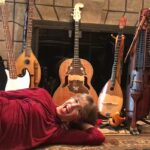
A note from the Board: As many of you saw in our latest newsletter, the Board has debuted a new method for recruiting future members to the Board of Directors. Lea Anne Kangas is the last individual to join via the “old” method (where current board members approached individuals who seemed to be likely candidates for prospective board service), and we wanted to explain why. Barbara Uhlemann is scheduled to step down from her position as Treasurer at the end of 2020. Because this position is critical to the financial health and stability of our organization, we wanted to have someone shadow Barbara through a full fiscal year. Ideally, we would have had Lea Anne go through our new application process. However, the Board collectively agreed that training a successor for the Treasurer position was urgent enough to warrant bringing Lea Anne onto the Board before the new process for nominations was finalized. Given her experience, particular skill set, and commitment to our organization, her application would have undoubtedly been successful, and we are already enjoying the benefit of her expertise.
Lea Anne Kangas, Finance and Program Committees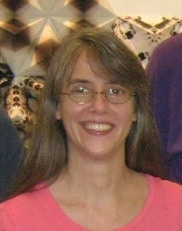
How did you first discover our Balkan Music & Dance Workshops (Balkan Camp), and what keeps you coming back?
I started folk dancing in junior high with an after-school group, and my friends and I continued dancing throughout high school. At some point, I found I was enjoying Balkan dances the most. I have a geeky music degree (theory/comp), but in school we didn’t delve much into odd meters and we studied virtually no folk music. One evening at folk dancing, a handful of people who’d recently returned from Balkan camp stood in the middle of the floor and played instruments I’d never seen before while we danced around them. I was intrigued.
Fast forward a couple decades: I’d joined an IFD (international folk dance) band as a singer. One day, a bandmate who was going to be out of town during an upcoming gig handed me her Macedonian tambura so I could help fill in on chords. I’d never done anything like that before, and I had so much fun with it that the next time a tambura went up for sale on the EEFC listserv I jumped at the chance. Then it was time to actually learn how to play the thing! Fortunately, that summer, an opportunity opened up where I could attend camp.
Thus began a cascade. It seemed I suddenly wanted to play a whole bunch of instruments, at the same time experiencing a renewed interest in singing. I didn’t really expect everything to take off the way it did.
Friends keep me coming back. Plus all the special moments that happen at camp, sometimes when you least expect them. Being around so many fantastic teachers and musicians who are part of these traditions. I get my annual boost of learning, a leap ahead in growth which carries me through the next year.
I love kafana. I think it’s so neat that anyone is welcome to play there, but then you also get to see some really top-level performers in the mix. I like to see the younger folks as they develop, and I love the energy and creativity of campers of all ages and playing levels. I love the student ensembles, being part of them as well as listening and dancing to them, people coming together to put on a dance party for the entire camp. Having fun together while creating a whole that is greater than the sum of the parts.
What is one of your favorite memories of Balkan Camp?
The first year was the most special. Though I barely knew my way around the tambura, I was encouraged to attend izvorno (Macedonian village instrument) ensemble. I could barely keep up on some of the tunes, but I was nonetheless welcomed, and my fellow tambura players helped me by showing me simple chords. It was such a high to be part of the student ensemble performance that year.
Have you volunteered with the EEFC before? If so, in what capacity?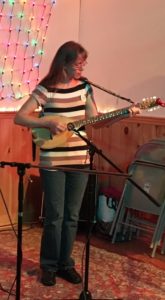
I’ve been on the Program Committee for several years, which has been an interesting and fun way to serve, as well as a means to get to know more people.
What inspired you to become a board member?
The opportunity opened up to use my particular skill set, and I’m happy to do that for this community that I love. I am sincere in striving to evaluate things fairly. I am excited for the present as well as for the future. I’d like to see us continue to do what we do well, balancing what we have that works for people with looking forward, recognizing that some things change and technology evolves.
What Balkan projects/events/bands/groups do you participate in?
Over the years I’ve been in several Balkan bands and performing groups. I’m currently a member of Hajde, which plays bitov (Bulgarian village) and izvorno music, and recently some friends and I started meeting regularly to do Balkan singing. I continue to dance at our monthly Balkan Night and weekly international groups. My musical life is quite busy, involving several non-Balkan genres as well, and I am accumulating quite a variety of instruments!
What would you tell someone considering attending Balkan Camp for the first time?
If you can manage to go for the full week, do it! Try to immerse yourself. There’s a magic that happens by the shared experience as you go through the week together at camp. Check out all that goes on: kafana, sings, jams, culture corners, blender bands, and maybe even sleep a little.
Membership FAQs
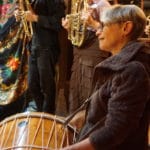
What are the benefits of membership? The primary benefit of membership is that it helps the organization offer discounted tuition at $950 to all adult campers, even steeper tuition discounts to youth campers, and covers our incredible team of work exchange recipients. The true cost per camper, regardless of age or work exchange status, is around $1,200 per person. As an organization, we want to ensure that our workshops remain accessible, so we make up the difference through fundraising and membership. Through the combined efforts of individuals, families, bands, choruses, dance groups, corporations, and matching funds, we’re able to hold the line at $950, and we plan to continue doing so for as long as we responsibly can.
There are some additional perks, too. When you become a member, you get your name on the EEFC website. Individual Members get a $10 Kafana card. Households of note or higher get a $20 Kafana card, and Group Members are eligible for the fiscal sponsorship through the EEFC on mission-aligned and approved projects. But our favorite perk is the warm, fuzzy feeling you get from supporting the music, dance, songs, and community you love.
When is the best time to become a member/renew my membership? January and February! This is when the organizations puts down payments on a lot of the hard costs associated with our workshops, and funds are tightest.
How long does my membership last? Unless you are a Lifetime Member, your membership ends with the calendar year. In other words, regardless of when you join, your membership will end on December 31st of that year. For example, if you renew your membership for 2019 on December 30th, your membership will end on December 31st, 2019 at midnight. This is why we encourage donors to join/renew in January and February. However, your membership is most welcome at any time of year.
Which membership is most helpful to the EEFC? Sustaining members are the lifeblood of our organization. Thanks to the financial predictability they provide, we’re able to plan ahead, pay our staff and bills on time, and stay focused on what really matters–promoting, celebrating, and educating the public about Balkan music, dance, and cultures.
I can’t afford the Individual Subsidized membership level. Are there other ways for me to contribute? Yes! Membership levels are just suggestions. You can donate at any amount at any time. Even $1 is meaningful to us. If financial support isn’t an option, consider donating your time or expertise. You can join a committee, host a fundraising event, or promote our workshops by passing out flyers and sending email invitations to friends. If you need organizational support for your fundraising ideas, please reach out to media@eefc.org.
I donated $75 or more to the EEFC via the auction at one of your workshops. Am I a member? Auction donations, although very much appreciated, do not count toward membership, because you are purchasing goods and services.
Strategic Vision 2019
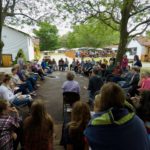
Over the past year, the Board has been hard at work considering our current needs and ideal
visions for future growth. We know that we can do more to maximize the use of our
community’s diverse talents, fulfilling our broader potential as a nonprofit focused on education
and public outreach about Balkan music, dance, and culture. We polled the community about
people’s thoughts, concerns, and hopes, and kept these conversations close at hand as we
debated the way forward. The Board remains committed to fleshing out a detailed Strategic
Plan that will see our organization stabilize and thrive. This full plan will take some additional
time and careful consideration to complete.
However, the Board feels that some aspects of our organization’s needs must be addressed
before wider aspects of that plan can really come together; namely, we need to attend first to
the more immediate financial needs of our community. As such, our Board has put together the
following Strategic Vision before moving on to broader plans for our organization. Below are
some of the key areas that we feel need to be tackled first.
The Hard Costs of Camp
Per the survey, 72% of campers think that we should maintain our current geographic focus,
and 90% think we should continue our tri-part focus on dance, singing, and instrumental music.
In addition, campers are interested in expanding our range to include folk art, cuisine,
costumes, and contemporary music styles as well as satellite programming for local
communities.
The expenses involved in putting on the workshops that people love remains more or less the
same from year to year. The annual budget has been around $400,000 for the past three
years. Why the consistency? Because the majority of our budget goes to hard costs.
- 60% of our budget goes straight to room and board (housing and feeding our
community). - 25% goes to the administrative and organizational efforts that make camp possible.
- 15% goes to travel expenses and modest stipends for the teachers who make camp
such a rich learning experience.
It is clear that our community is not interested in reducing programming at this time, but there
just isn’t any more fat to trim. The Board wants to ensure that we can sustain our current camp
experience into the future. However, we have experienced some significant deficits in the
recent past. Many of you have responded generously to fundraising efforts, but we have still
experienced shortfalls. In part, this is the result of our decision to keep camp tuition lower than
our actual cost, but it is also the result of lower than hoped-for attendance.
We will be taking a two-pronged approach to bolster our financial health. First, we want to work
to establish a more sustainable tuition structure, while informing the community about our
actual costs. Second, we want to maximize our fundraising activities. This includes broadening
options for giving so that donors can support areas of programming that are meaningful to
them as well as most helpful to the needs of the organization.
A Proposed New Tuition Structure
Full time adult camp tuition is currently $950, but we estimate that the actual per-person cost is
about $1,200. We cannot significantly reduce expenses without making big changes to the
quality of camp, and yet, we want to keep welcoming folks who may not be able to pay the full
cost. For years, we felt that changes to tuition were off the table. However, survey responses
showed that only 6.5% of campers think that camp is too expensive. In fact:
- 11.5% of campers think our workshops are a steal.
- 49.5% of campers think our workshops fairly priced.
- 32.5% think tuition is high, but also affirm that camp remains accessible through scholarship and work exchange opportunities. (We currently award roughly 30 scholarships per year with over 75 work exchange positions.)
Over the summer of 2019, therefore, the Board is exploring the feasibility of a multi-tiered
approach for adult camp tuition fees. (Children’s fees will be unaffected in order to support
young families.) We would offer this tiered tuition structure in order to continue to support those
individuals who may not be able to pay full tuition, while accounting for what it actually costs
the organization for an individual to attend camp. We expect to decide on a new tuition
structure by late fall 2019, and to pilot it for both camps in 2020.
Below is one proposal for a camp tuition scale, one that could have a profound impact on our
bottom line.
- $950—Community Beneficiary: As we have done for many years, we are proud to
offer discounted tuition (below actual cost of camp) to those with limited income. The
remaining hard costs of your stay at camp are covered thanks to our “Merak Co-
Creator” campers (see below) and community fundraising efforts. We envision this
tuition level for students, low-income individuals and families, and retirees. - $1200—General Tuition: Attending at this level covers all the hard costs of your stay at
camp. By paying this tuition, you help fully cover our operating costs. - $1450—Merak Co-Creator: This level completely covers the cost of your stay at camp
and pays it forward for one of our Community Beneficiaries. Thank you for helping us
spread the kefi!
These numbers refer to adult full-time tuition; options for children, part time, etc. would be
similarly calculated. Please note that the proposed tuition tier system is not a camp
tuition increase! Under any new tuition structure, attendees can continue to pay at the current
tuition level according to their needs. We are thrilled to have you join us at whatever tuition
level fits your circumstances.
If just 24 campers chose the General Tuition it would close our budget gap by $6,000. That’s
how much we typically earn at the auction in Mendocino. Wide community participation would
boost our finances and enable us to expand programs and scholarships.
Our Development Infrastructure
We have transitioned our organization’s database to the SalesForce system. We have trained
our staff and established best practices that marry the platform’s strengths with our (fairly
quirky) organizational needs. While improving our internal operations, we’re beginning to reap
the benefits of this transition. Salesforce allows us to efficiently analyze and manipulate
decades of data to better understand our organization at macro- and micro-levels. This is
especially useful to the Development Committee who can now manage memberships and
donations in real time. Community members will see the impact through regular membership
reminders, coordinated membership and capital campaigns, and consistent organizational
updates relevant to our donors’ interests. Furthermore, we have increased the hours of our
Manager of Marketing and Development to a quarter-time position (10 hours per week) to
provide the necessary support to keep pace with expanded development work.
Major and Planned Gifts
We are expanding the ways you can give to the EEFC. Previously, donors had three options:
giving to the General Fund (Operations), to the Endowment, or to scholarship funds. While
these areas of giving are critical, some benefactors may feel passionate about specific causes
close to their hearts. The development committee is exploring new giving programs to allow
donors to preserve a piece of history at our workshops. We want to create opportunities that
keep names and legacies alive in the community, much like the Crum/Kef scholarship fund.
Also, we’d like to partner with donors in order to underwrite diverse aspects of camp through
five- and ten-year designated funds. This giving practice allows us to safeguard our
organizational history and traditions, boosts financial predictability, and gives our organization
the flexibility to determine new areas of need as our circumstances change. If you would like to
learn more about how you can underwrite dimensions of the camp experience or create a
legacy for yourself or a loved one, please contact Jenna Shearer (j.shearer16@gmail.com).
Our work expanding donor options dovetails with our efforts to establish more straightforward
guidelines and support for community members interested in planned giving. By late fall of this
year, the development committee will prepare written and digital materials to guide those looking to make bequests to our organization. If you have written the EEFC into your will and are willing to talk to members of the development committee regarding your experience, please contact Jenna Shearer (j.shearer16@gmail.com).
Investigating Alternative West Coast Campsites
In working on the vision for the organization’s future, the Board concluded that (due to a variety
of factors) our Mendocino location is at risk and we want to ensure continuity on the West
Coast. As such, the Board has formed a committee to investigate and draw up a list of venues
that we might consider should there be a need to relocate our West Coast workshop. At this
time we have no plans to move, but given the fire danger which has demonstrably grown
worse in California, it is prudent to research alternative locations ahead of potential necessity.
We know that our community is deeply attached to the site in the Woodlands. We also know
from recent surveys that the challenging terrain and dust keep some people away. Please be
assured that the Board and committee are mindful of all of these considerations as we
proceed.
We will be happy to research any sites you suggest. Please send your recommendations to
Barbara Uhlemann at barbara.uhlemann@sbcglobal.net. The members of the committee
are EEFC Board members Barbara Uhlemann and Craig Kurumada, joined by Lise Liepman,
Barbara Babin, Caroline Simmonds, and Polly Ferber.
In Conclusion
While our board members, task force, and committees continue to research our options for
expansion and growth, Phase One of our “strategic evolution” begins here: by addressing our
most urgent and fundamental needs. While these may not seem very glamorous, we
wholeheartedly believe it is the right place to begin building the foundations for future stability
and growth. The speed at which we’re able to hit our short-term financial targets will inform
future, long-term programs for advancing the mission of the organization. These decisions will
become the basis for a full-bodied Strategic Plan.
Please know that the Board is committed to moving forward with integrity and transparency so
that you—the community—continue to partner with us to craft a healthier and stronger
organization. If you have any questions, please take the opportunity to speak to a board
member or send us an email at board@eefc.org. Thank you for your continued
support, and please stay tuned for exciting updates as we move ahead!
East European Folklife Center Board of Directors
Camp Cabins Are Not Just Where We Sleep
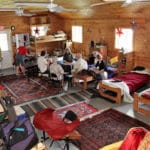
By Margaret Loomis
Our folk music and dance community has given us many invaluable gifts, including friendships that may span decades. Some camp friends we see frequently, or now and then, and some only at camp once a year. Some of these friends become our cabin mates, either by happenstance or by design.
And speaking of design… when you think about packing for camp, what goes on your list? Clothes for hot weather, and chilly weather, and don’t forget wet weather, instrument(s), song words, comfortable dance shoes, earplugs, sheets and blankets, toothbrush… the usual stuff. And what else?
When we move into our cabin, we set the stage for our week. Here’s a sample list of extra items that appear in Cabin 16 at Iroquois Springs at the beginning of camp each August: two room-size oriental-style carpets and several long Balkan carpet runners to fill in the gaps, small bedside rugs, occasional wall hangings, five extra fluffy bathmats for underfoot luxury in our bathroom, fantastic strings of bright, colorful lights for our porch, a collection of illuminated Indian stars for indoor cabin mood and décor, a collapsible rocking chair for our porch, extra folding chairs for indoor entertaining (and music practice), a round brass table for Turkish coffee-making apparatus and assorted snacks (which can also be found in cabin cubbies), three AeroPress coffee makers and gourmet coffees, a communal hanging rack for clothes, several wall clocks, an electric tea kettle… and a minimum of three santouris. Sometimes as many as five. Oh, sorry, the santouris aren’t part of the “extras” list, they are essential for our cabin.
Cabin 16 is “Santouropolis,” so named for our santouri population and supportive, accommodating cabin mates who are accepting of early morning tuning (“plink, plink, plink”) and even say they enjoy napping during our afternoon practice sessions. But you don’t need santouris to have an inviting, warmly decorated cabin where you can enjoy snatches of time between classes, parties, practice sessions and other commitments; or where you can invite new and old friends in for a moment of music, talking, snacking, or drinking your beverage of choice.
So… how does a cabin like this happen? For us, a group of long-time camp friends who have mostly “bunked in” together for many years, it has evolved over time – we’ve been lugging all this gear to camp for just about as long as we can remember. Much of it is now routine, but there is also some planning involved, and we typically chatter amongst ourselves over email for a month or so leading up to camp. If someone can’t make it in a given year, it’s “Who can bring fans this time?” or, “Who will bring bathmats this year?” Or nightlights, or extra rugs.
Why do we do this? Because it’s fun and it makes us happy. We enjoy our home-away-from home. It’s collaborative. It’s atmospheric and visually pleasing. We enjoy it when a cabin mate brings a friend by, or someone sticks their head into the cabin looking for one of us, and their eyes widen in surprise as they look around. Admittedly, bringing all of our cabin accoutrements got a little more cumbersome when we moved to Iroquois Springs in 2005, where we’re not allowed to drive up to our cabin to drop things off. But we’re still schlepping our gear, and we still feel it’s worth it. Even for just a week.
Anyone can spruce up their cabin space to make it more comfortable and appealing. If you know any of your cabin mates ahead of time, you can do a little pre-camp planning. If you don’t know who you’ll be living with for the week, you can bring a few items on your own, for your own area and/or for shared areas – a rug, some lights for your porch, something bright or fun to hang on your walls… get creative. Start somewhere and see where it goes, and maybe you will inspire others in your cabin to join in. Your own, personalized cabin atmosphere might just evolve over time. We do all plan to be going to camp forever, don’t we?
Tips for Scholarship Applicants
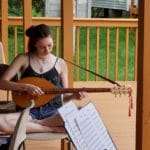
Scholarship applications are live! Application deadlines for 2020 are:
- West Coast/Mendocino workshop: March 9, 2020
- East Coast/Iroquois Springs workshop: April 15, 2020
We encourage dancers, singers, and instrumentalists to apply whether they are new to Balkan music and dance (and our workshops) or veterans; whether they have Balkan roots or not; and whether they are professionals or amateurs. Above all, we are looking for people who will help us spread the joy of Balkan music and dance! However, the application process can be intimidating. The Scholarship Committee has put together the following tips to guide you, because ultimately, we’re all rooting for your success!
- Scholarships are awarded on the basis of written applications. CDs, websites, music samples, and the like are not reviewed during the decision process. However, we are well aware that writing isn’t everyone’s forte. Before you get frustrated, we encourage you to ask a friend for assistance! Cook a buddy dinner or treat them to coffee while they help you craft an application that truly reflects your talents, goals, and personality. Obviously, don’t have someone write the whole thing for you, but don’t suffer in silence if writing is really hard for you or if English is a second language. We get it!
- Don’t use your phone to submit applications. Unless you want to represent yourself with short and disjointed answers riddled with poor punctuation and the heavy-handed influence of autocorrect, just don’t do it. This is one of those instances where using an actual computer will go miles toward your success.
- Use the rubric. We’ve published the exact criteria that you’ll be judged on under the “Scholarship Details” tab on our website. Use this insider knowledge to shape your responses. It’s really easy to tell who has read the website thoroughly and who hasn’t. This tells us a little bit about an applicant’s levels of focus, grit, and discipline. Everything on our website is for your benefit, so use it!
- Try for every scholarship that applies to you. In other words, you may apply for more than one scholarship at a time. For example, an East Coast singer should apply for a Dick Crum/Kef Scholarship, the Stefni Agin Scholarship, AND the Susan K. Anderson Scholarship. An East Coast dancer should apply for a Dick Crum/Kef Scholarship, the Cooper Scholarship, AND the Susan K. Anderson Scholarship. Similarly, East Coast gajda players should apply for a Dick Crum/Kef Scholarship, the Vassil Bebelekov Scholarship, AND the Susan K. Anderson Scholarship. Make sense? Throw your hat into the ring as many times as you can.
- Never give up! This is a competitive process, and it is very common for applicants to apply more than once before receiving their first scholarship. But scholarships aren’t the only way to get to camp. If we can’t give you a scholarship this year, please apply for a work exchange position by emailing your coast’s Site Manager! It’s a great way to integrate into the community, and while you may have to battle a little FOMO, there’s so much to do at our workshops every hour of every day that we guarantee you’ll get your fill of music, dance, and laughter.
